
views
Preparing to Write Your Essay

Read the assignment carefully. If your teacher has provided a handout of what they want from you, then read this handout very carefully. It probably includes all of the information you will need to get a good grade on your essay. If your teacher only told you about the essay assignment in class, hopefully you have taken notes on what you should be doing. If you didn’t take notes, go back to your teacher and politely ask them questions about the assignment to get all the instructions you need. Should you choose your person or has one been assigned? Does your teacher want you to use a citation style? For example, they may want you to use the MLA format or maybe they want you to use Chicago Style. If your teacher says they don't care, then there's nothing to worry about, but make sure that you include a “References” page at the end of your essay. On this page, you should include all of the different websites, books, and/or magazines that you used to write the essay. Is there a word limit? Does your teacher require a specific font or font size? Should you double-space the essay? If you're not sure, ask you teacher.

Choose a person that did a lot in their life. If you are able to choose who you write about, then think about it carefully. Don’t just pick the first person that comes to mind. Choose someone that is interesting to you personally. This will make learning about this person and writing your essay more fun. Try to think about the things you know the person has done. Did they live a pretty normal life, but did one really cool thing? A person who was more or less “normal” could be harder to write about if your teacher wants a ten page essay. For example, although Adolf Hitler was not in any way an admirable human being, writing a historical essay about his life would be pretty easy because he did a lot of different things. On the other hand, if there is a historical figure you are really interested in, you will have a good time researching and writing about your person whether they led very busy lives or not. The most important thing is to choose someone you find fascinating. Try making a list of your hobbies and interests and then run a Google search to find famous people who also had one of these hobbies or interests.
Brainstorm a list of questions. Write down all of the questions you want to answer about your person. If your teacher told you what questions to answer, then use those. If your teacher did not, then this is up to you. Make sure you talk about when and where they were born, whether they had a good childhood or not, what makes them special and interesting, what they accomplished (whether good or bad), and why you find them interesting.

Research the questions you want to answer in your essay. Now that you have some questions, you can start finding out all the information you need to know to write your paper. This is called research. Start by searching the internet for information about your person. Don’t forget to search your school library for information. Write down anything you find interesting and want to include. At the same time that you do this, write down the source of that information. For example, the name and author of the book or the address of the website. If you are having a hard time finding information about your person in the library, ask the librarian to help you search. They’re there to help you, and may have ways of finding information that you hadn’t thought of. Plus, if you find the information through the library, there is a better chance that you will find high quality information. Make sure that you understand what is considered an acceptable source of information by your teacher. For example, some teachers may consider it OK to use websites such as Wikipedia, while other teachers may not. If you’re not sure, just ask them. Try to include at least one primary source that was written by the person you are researching, such as a letter, journal entry, or speech. This will help you get to know the person better than you would by only using secondary sources, such as articles and textbooks.
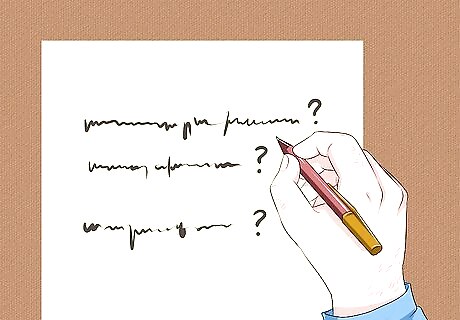
Outline your essay. Sometimes it can be difficult to know how to get started on an essay. Writing an essay outline will help get you started and will also help you have a clear idea about what information you want to include. Include in your outline the questions you developed in your brainstorming exercise as well as the answers to the questions you found through research. Write your outline so that the information is in the same order that it will be in in the paper. For example, don't put questions about how the person died before the questions about where they were born and who their parents were.

Review other essays. Ask your teacher if they have an example essay that you can look through. Many teachers keep one or two really good essays written by past students. Don’t plagiarize though! If you copy someone else's work without giving them credit for their work, this is called plagiarism. If you do find something interesting that you want to include, be sure to give credit to that person. Plagiarism is a big deal, so it’s best to learn early that it isn’t worth the risk.
Writing the Essay
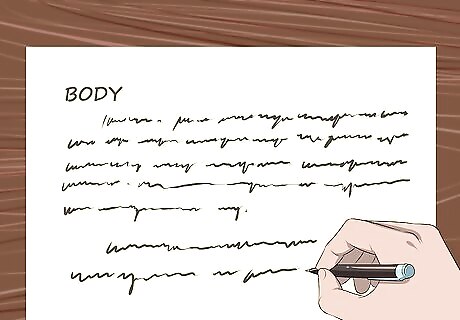
Start with the body of the essay. In most cases, essays will be made up of three parts: the introduction, the body, and the conclusion. In the introduction you will introduce your person, and talk briefly about what you will be writing about. You may already have a good idea of what to include in the introduction based on your outline, or you may find it easier to write the introduction if you first write the body of the essay. In the body, you will write about all of the information that you found when you were researching. It is the part of the paper where you answer any and all questions you have come up with. Your essay will be more clear if you separate different parts of this person’s life into paragraphs. For example, the first paragraph might start out by explaining when, where, and to whom this person was born. In this paragraph you might talk about what kind of childhood this person had, and whether they had any big experiences that made them into the person they were. In later paragraphs, you can talk about what the person did that made them famous. You might also want to include interesting things that you found about this person’s personal life. For example, whether or not they got married or whether or not they suffered from any mental disorders.
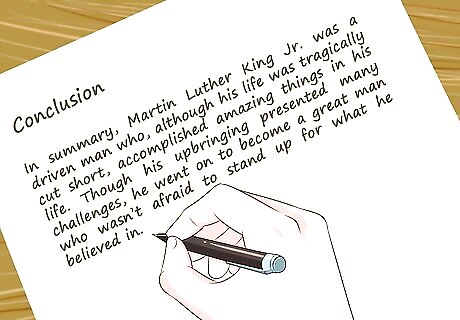
Write the conclusion. The conclusion of the essay is where you will summarize everything you have written about this person in the body. In the conclusion you will not bring up anything new about the person. If you find yourself trying to include something new, then go back and find a place to include this in the body of the paper. Don't write more than one or two paragraphs for your conclusion. It should simply go over what you have written in the body about who this person was and why they were interesting and important. For example, you might write, “In summary, Martin Luther King Jr. was a driven man who, although his life was tragically cut short, accomplished amazing things in his life. Though his upbringing presented many challenges, he went on to become a great man who wasn’t afraid to stand up for what he believed in.” In the next paragraph, you can summarize what you wrote about why you find him so interesting. For example, “This great man inspires me every time I read about him. I hope that I too can stand up for the right thing if I am ever in a position to do so, even if it is difficult or scary to do so.”
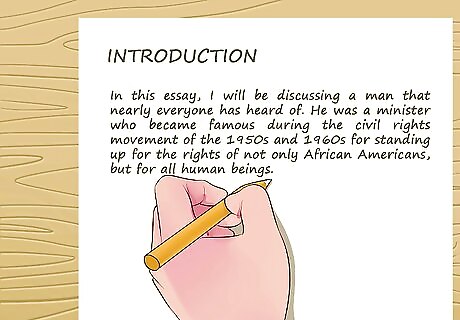
Finish your first draft by writing the introduction. Now that you have written the body and conclusion of the paper, you will have no problem writing the introduction. In this section, introduce the person you are writing about, and state what they were most famous for. Then, in a few sentences, outline what you will be talking about. For example, you can say, “In this essay, I will be discussing a man that nearly everyone has heard of. He was a minister who became famous during the civil rights movement of the 1950s and 1960s for standing up for the rights of not only African Americans, but for all human beings.” After you introduce your person, you will state what you will be telling your reader about this person. For example, “In this essay, Martin Luther King Jr.’s life will be discussed beginning with his birth in Georgia, to his travels to Germany where he officially began to be known as ‘Martin,’ to his untimely death in 1968.” Don’t give everything away in the introduction. Think of the introduction like a movie preview. You want to give enough information to get the reader interested, but not so much information that they will already know everything else written in the essay before they read it.
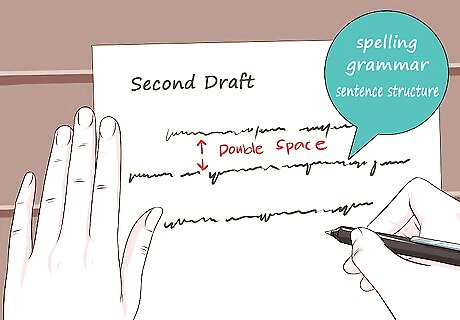
Write a second draft. What you have written now is considered the “first draft” or “rough draft.” In the first draft there is no reason to worry about spelling, grammar, or sentence structure. The idea is simply to get all of the things you want to say down on paper. After you have finished the first draft, you can begin on the second draft. Don’t expect the second draft to come out perfectly either. The purpose of the second draft is to fix up any major spelling mistakes or grammar errors, and to see how you feel about the information you’ve written now that it’s all out there. A second draft is what you will give to anyone who has offered to proof read your essay, so make sure that it is easy to read. It is best to have this version typed and double-spaced so it will be easy for whoever is helping you to make notes on things you can improve in your final draft.
Editing Your Essay

Ask someone to proofread your essay. You can ask a friend, a parent, or other family member, but try to choose someone you know will really spend time checking your paper for errors, and will also pay attention to what you've written. A lazy friend might glance through your essay for spelling errors. However, what you really want is someone who will evaluate what you’ve written to point out places where you can improve. For example, a good proofreader might point out to you that your paragraph about the death of your person might be better if you put it before your paragraph which talks about the legacy this person left behind. Try asking a classmate to read your essay. It's a win-win for both of you because you can offer to read their essay in return. Meet up a few days after reading to talk about errors and ways to make each of your papers better. If the person has done a good job, they may have a lot of things to say about your paper. Try not to take anything bad they say about your paper personally. They're not trying to make you feel bad, they just want to help you get a good grade. Give them a physical copy of the paper that is double-spaced. This will make it easy for them to make corrections and write notes on your paper.

Proofread the essay on your own. After you have made any corrections or changes based on the feedback from your helper, go back and proofread your own essay. Try to pretend that you are reading this for the first time, and that you are reading someone else’s essay. Make notes as you read in a bright colored pen on a physical copy of your paper. Read your paper twice. The first time, focus on what you've written, and don't look for spelling mistakes or other grammar errors. While you're reading think about whether it is easy to follow and whether or not it makes sense. This will be the time to consider rearranging any information, adding anything extra, or removing anything that doesn't seem important. Read through the article a second time to check for grammar and spelling issues. Mark any misspelled words or typos, and make a note of any awkward sentences that you want to go back and change.
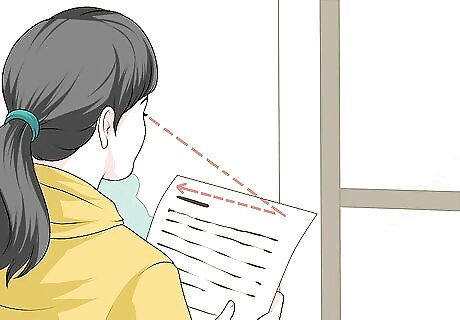
Read the essay backwards. It may sound strange, but reading the essay backwards sentence by sentence helps you to focus on each sentence. This will make it easier to catch mistakes. You should also read the essay out loud. Reading the essay out loud will help you find sentences that sound strange.

Type your final draft. Once you are satisfied with your work, prepare your final draft. If you have only handwritten your essay, then you will need to type the entire thing on the computer. If you already have a computerized draft, then you don’t need to re-type the entire essay, but go through and fix any mistakes that you noticed. Make sure to follow any instructions your teacher has given you about how to format the document. For example, with regard to font, font size, and line spacing. By now, you should feel confident that you have a well-written paper. If you still feel unsure, you can ask a different person to read your essay to reassure yourself that you have caught any mistakes. If your teacher said they don’t care about the formatting, then stick to the defaults of your word processing program. Generally, it is a good idea to stick to font size 12 and a standard font such as Times New Roman. To make your paper easier to read, consider changing the line spacing to 1.5 or 2, unless your teacher has said not to do this. Your teacher probably expects you to turn in a typed copy of your essay. Unless your teacher has specifically asked for handwritten papers make sure you turn in a neat, typed copy.

















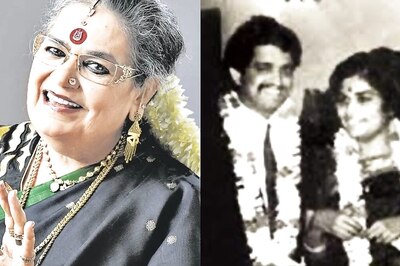

Comments
0 comment